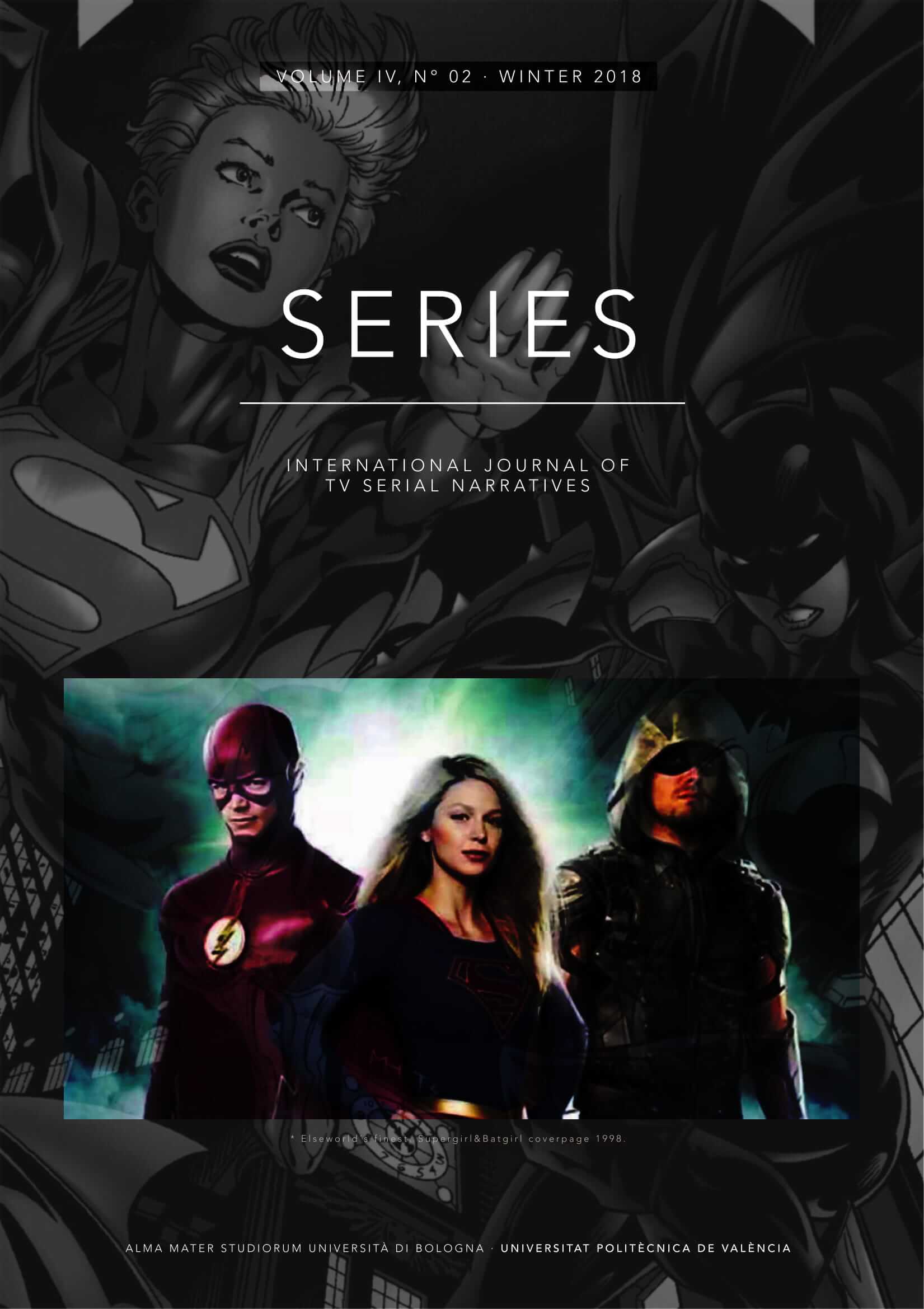Angels, demons and whatever comes next: the storyworld dynamics of Supenatural
DOI:
https://doi.org/10.6092/issn.2421-454X/8164Keywords:
storyworld, narratology, writing, ethos, showrunnerAbstract
This paper explores the narrative dynamics of the fantasy television series Supernatural (2005-) in order to better understand how this particular program has become a backbone of The CW network. Combining formal and contextual narratologies, it blends a close-reading of the series with an analysis of its writing, production and reception contexts, and divides the long-running series into four eras, each defined by a specific showrunner. It starts by exploring the context of the series’ creation, before cataloguing the shifting dynamics of the storyworld during the four eras: the ‘stealth teleological’ approach of series creator Eric Kripke; the complex reconfigurations of the Sera Gamble era; the ‘mythology reboot’ of the Jeremy Carver era; and the ever-increasing stakes and expansionist dynamics of the Andrew Dabb era. The aim of this paper is to show how ‘periodising’ a long-running series by using close-reading and studying the dynamics of a storyworld can expand and complete analysis focused on audiences and the genesis of the text..References
(2007). “Eric Kripke Fields Your Questions About Supernatural.” TVGuideNews. www.tvguide.com/news/eric-kripke-fields-35627 (last accessed 07-05-18).
Amossy, Ruth (2009). “La double nature de l’image d’auteur.” Argumentation et Analyse du discours, 3. http://aad.revues.org/662.
Ausiello, Michael (2010). “Exclusive: 'Supernatural' boss on why he stepped down and what's coming up (hint: monsters!).” Entertainment Weekly. www.ew.com/article/2010/07/15/supernatural-season-6-spoilers (last accessed 07-05-18).
Baroni, Raphaël (2007). La Tension narrative : Suspense, curiosité et surprise. Paris: Seuil.
Bennett, Tara (2014). Showrunners: The Art of Running a TV Show. London: Titan Books.
Booth, Paul (2014). “Periodising Doctor Who.” Science fiction film and television 7(2): 195-215
Cardwell, Sarah (2006). “Television Aesthetics.” Critical Studies in Television 1: 72-80.
Carroll, Noël (2007). “Narrative Closure.” Philosophical Studies, 135: 1-15.
Doležel, Lubomír (1998) Heterocosmica: Fiction and Possible Worlds. Baltimore, London: John Hopkins University Press.
Escola, Marc (2010). “Le clou de Tchekhov. Retours sur le principe de causalité régressive.” Fabula. www.fabula.org/atelier.php?Principe_de_causalite_regressive (last accessed 07-05-18).
Favard, Florent (2014) “The Yellow umbrella syndrome: Pledging and delaying narrative closure in How I Met Your Mother.” GRAAT Anglophone studies 15: 24-49. http://www.graat.fr/2favard.pdf (last accessed 07-05-18).
Favard, Florent (2015). La Promesse d’un dénouement : énigmes, quêtes et voyages dans le temps dans les séries télévisées de science-fiction contemporaines. PhD dissertation. Bordeaux: Bordeaux Montaigne University.
Favard, Florent (2016a) “Mapping macroscopic plots in narratively complex television series.” Revues française d’études américaines,151: 72-85. www.cairn.info/revue-francaise-d-etudes-americaines-2017-2-p-72.htm (last accessed 07-05-18).
Favard, Florent (2016b) “You can(’t) let go now: Mystery boxes, quantum readings and very bright lights in Lost.” TV/Series HS1. https://journals.openedition.org/tvseries/1738 (last accessed 07-05-18).
Favard, Florent (2017). “Battlestar Galactica: A Closed-System Fictional World.” TV/Series 11. https://journals.openedition.org/tvseries/1993 (last accessed 07-05-18).
Favard, Florent (2018). Le Récit dans les séries de science-fiction, de Star Trek à X-Files. Paris: Armand Colin.
Gelman, Vlada (2012). “New Supernatural Boss on Returning to the CW Series and 'Resetting' the Mythology.” TVLine. http://tvline.com/2012/08/02/supernatural-season-8-carver (last accessed 07-05-18).
Herman, David (2002). Story Logic: Problems and Possibilities of Narrative. Lincoln: University of Nebraska Press.
Hills, Matt (2002). Fan Cultures. London: Routledge.
Jenkins, Henry (2006, revised edition 2008). Convergence Culture: Where Old and New Media Collide. London, New York: NYU Press.
Johnson-Smith, Jan (2004). American science fiction TV: Star Trek, Stargate and beyond. London, New York: I.B. Tauris.
Kermode, Frank (1967, revised edition 2000). The Sense of an ending. New York: Oxford University Press.
Macklem, Lisa (2014), “I See What You Did There: SPN and the Fourth Wall.” In Fan Phenomena: Supernatural, edited by Lynn Zubernis and Katherine Larsen. Bristol: Intellect Books.
Mittell, Jason (2015). Complex TV: The Poetics of Contemporary Television Storytelling. New York, London: New York University Press.
Mittell, Jason (2012). “Wikis and participatory fandom.” In The Participatory cultures handbook, edited by Aaron Delwiche and Jennifer Henderson, 35-42. New York: Routledge.
Mittell, Jason (2010). “Previously on: Prime time serials and the mechanics of memory.” In Intermediality and storytelling, edited by Marina Grishakova and Marie-Laure Ryan, 78-98. Berlin: Walter de Gruyter.
Mittell, Jason (2009). “Lost in a great story: Evaluation in Narrative Television (and Television Studies).” In Reading Lost, edited by Roberta Pearson, 119-138. London, New York: I. B. Tauris.
Örnebring, Henrik (2007). “The Show Must Go On… and On: Narrative and Seriality in Alias.” In Investigating Alias: Secrets and Spies, edited by Stacey Abbott and Simon Brown, 11-26. London, New York: I. B. Tauris.
Pavel, Thomas (1988). Univers de la fiction. Paris: Seuil.
Peck, Jason M. (2011). “Lost and Becoming: Reconceptualizing Philosophy.” In Looking for Lost: Critical Essays on the Enigmatic Series, 75-89. Jefferson, London: McFarland.
Radish, Christina (2010). “Executive Producer Eric Kripke and New Show Runner Sera Gamble Interview SUPERNATURAL.” Collider. http://collider.com/supernatural-interview-eric-kripke-sera-gamble (last accessed 07-05-18).
Ricœur, Paul (1983). Temps et récit 1 : l’intrigue et le récit historique. Paris: Points Seuil.
Ryan, Marie-Laure (2009). “Cheap plot tricks, Plot Holes, and Narrative Design.” Narrative, 17(1): 56-75.
Ryan, Marie-Laure (2010) “Cosmologie du récit: des mondes possibles aux univers parallèles.” In La théorie littéraire des mondes possibles, edited by Françoise Lavocat, 53-81. Paris: Éditions du CNRS.
Shen, Dan (2005). “Why Contextual and Formal Narratologies Need Each Other.” Journal of Narrative Theory 35(2): 141-71.
Downloads
Published
How to Cite
Issue
Section
License
Copyright (c) 2018 Florent Favard
Copyrights and publishing rights of all the texts on this journal belong to the respective authors without restrictions.
This journal is licensed under a Creative Commons Attribution 4.0 International License (full legal code).
See also our Open Access Policy.





